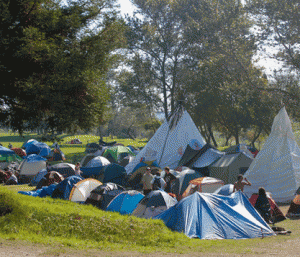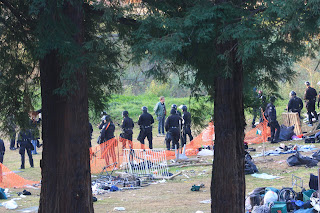Phillip Matier and Andrew Ross,
SF Chronicle , Tuesday, September 4, 2012

A city proposal would take chronic drunks off the street and force them into treatment programs they have refused. Photo: Brant Ward, SFC / SF
Chronic drunks in San Francisco could soon be sentenced to locked treatment for as long as six months, under a plan that has the green light from Mayor Ed Lee.
“We’ve done pretty well at getting some of these individuals to a point where they clean up a little bit – but when you leave them alone, they go right back to their old ways,” Lee said of the city’s current policy of releasing drunks when they sober up.
Under a plan being worked out by the city courts, the cops and the Public Health Department, chronic drunks who repeatedly miss their court dates would be held in contempt – five days for each missed appearance.
Contempt citations are handled by a judge – no trial required – although defendants still have the right to an attorney. Considering that some street drunks have missed 20 or more court dates, rolling the citations into one could result in a hefty piece of time.
And that’s the idea – take them off the street and force them into the treatment program they have repeatedly refused.
“If somebody has 20 warrants, you can pretty much guarantee that someone from the health department has offered them some type of help 20 times as well,” said Katherine Feinstein, presiding judge of San Francisco’s Superior Court.
For those sentenced, the first stop would be San Francisco General Hospital.
“These guys may look tough, but they are medically fragile,” said Barbara Garcia, head of the Public Health Department.
After the hospital clears them, the next stop would be a special wing of the city jail for treatment administered by health department workers.
“Thirty days wouldn’t hurt,” Garcia said. “Once people have been sober that long, they look pretty good and can maybe start to get a handle on their lives.”
Garcia said the hope is for a pilot program to be ready to go within 30 days.
Public Defender Jeff Adachi, whose office would represent many of those facing mandatory treatment sentences, questioned whether targeting drunks amounted to “selective enforcement,” and whether criminal proceedings were appropriate for people who suffer from what “I think everyone agrees is a disease.”
Adachi also wonders whether the jail is equipped to handle a rehab program.
Lee, however, says it’s worth a try – the sooner the better.
“This has been a long time coming,” the mayor said. “There are 68 people on the streets that have cost us tens of millions of dollars going in and out of the hospitals, courts and jail.
“I know who they are, too,” Lee said. “I spent six years at the Department of Public Works cleaning up after them.”
Road show: BART directors will hold special board meetings Friday – in Vancouver, Wash., and Clackamas, Ore. – so they can get a close-up look at how the system’s $484 million light-rail connector to Oakland International Airport is being manufactured.
But first they’ll fly into Portland on Thursday – where BART General Manager Grace Crunican last worked – to get a view of that city’s light-rail system.
BART’s delegation is expected to total 15 – five directors, Crunican and nine senior staffers. They’ll stay at the Hotel Monaco downtown, where – with a government discount – rooms run about $200 a night. Officials put the total cost of the trip, including airfare and meals, at about $8,100.
BART District Secretary Ken Duron, who has been with the transit agency for more than two decades, says the out-of-town meeting is a first for the board.
According to a BART agenda notice, Friday morning’s meeting will include a workshop at Thompson Metal Fabricators in Vancouver, where there will be “a discussion and review of (the) welding and finishing process” for the new Oakland tram structure.
Then it’s on to Clackamas, a suburb southeast of Portland, to see how the rail cars are being built.
But apparently there is more to it.
Hiring local workers has been an issue on the project, and “it helps if directors stare down the contractor and say, ‘We’re not going to accept 24 percent of Oakland residents working on the job site when we said 25 percent,’ ” said BART director Robert Raburn, who is among those going on the trip.
Raburn insists this is no junket. In fact, he says, he put his foot down when Oakland officials invited BART directors to go to Las Vegas last month to look at a tram system used by hotels and casinos there.
Oakland City Council President Larry Reid, for his part, says the Vegas trip wasn’t going to be a junket, either – he hoped to drum up support for adding a $15 million hotel stop on Hegenberger Road for the airport line.
A scheduling conflict forced the trip’s cancellation, Reid says, but a meeting was held in its place – at the Alameda County Transportation Commission‘s board room in downtown Oakland.





